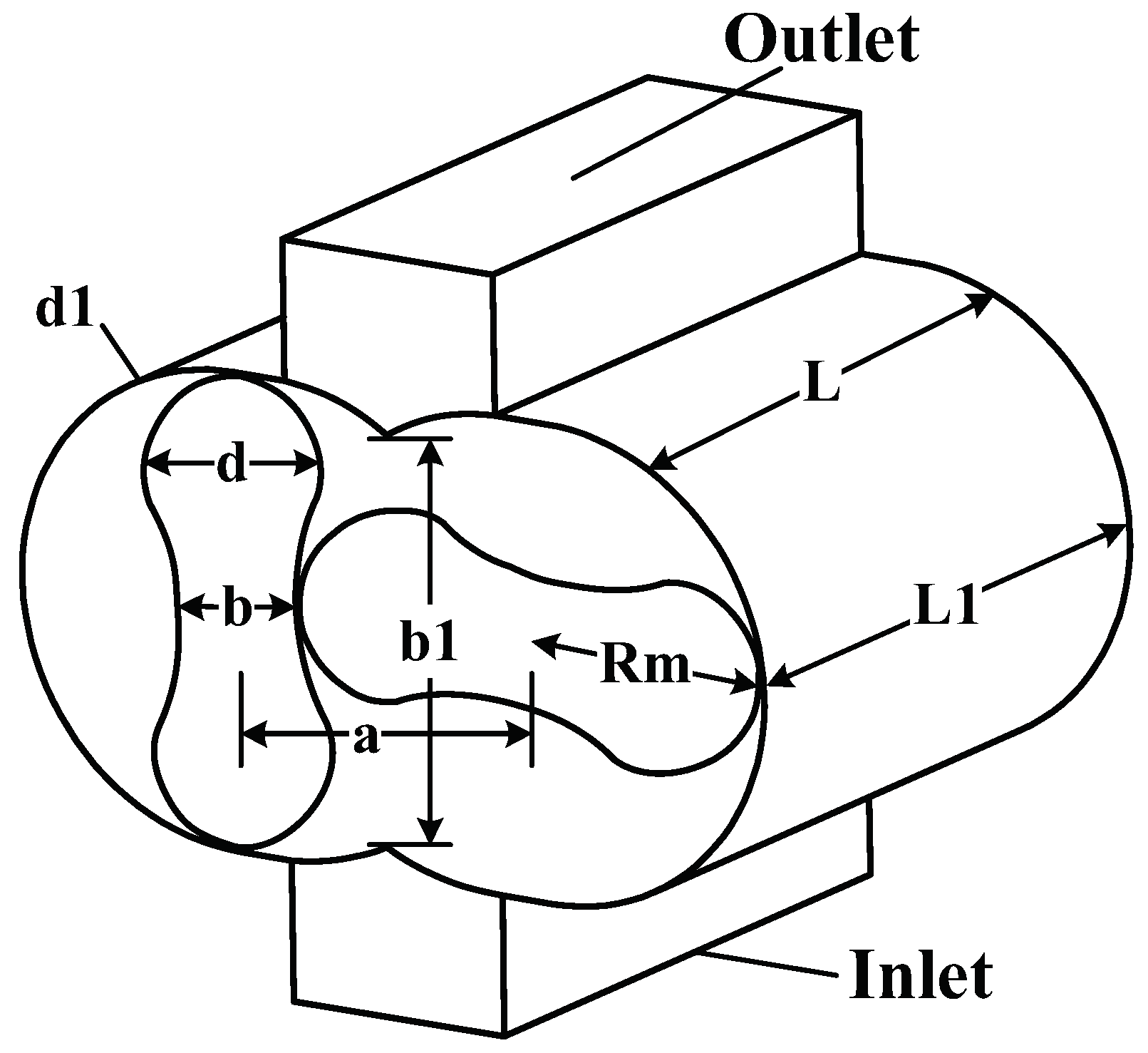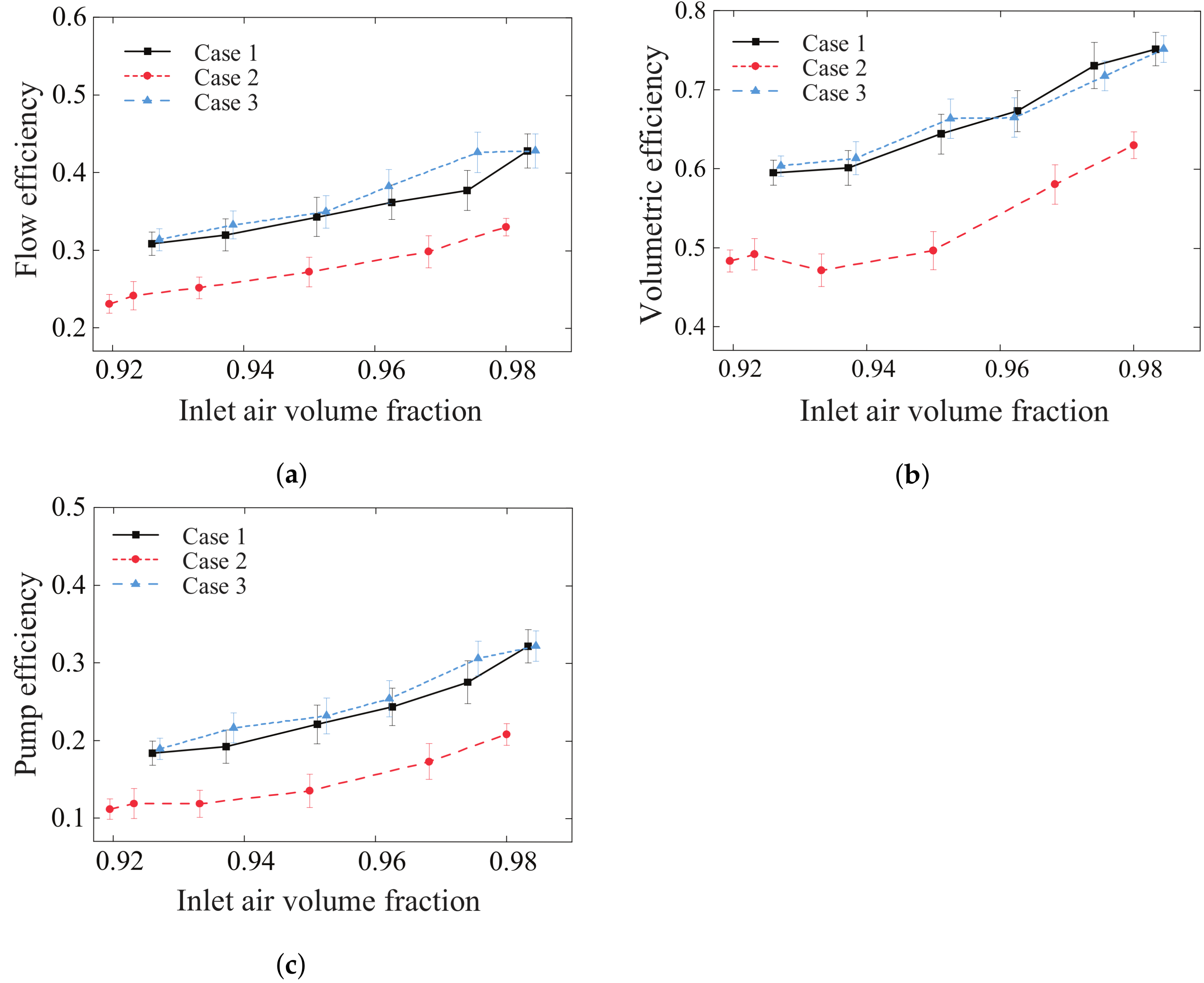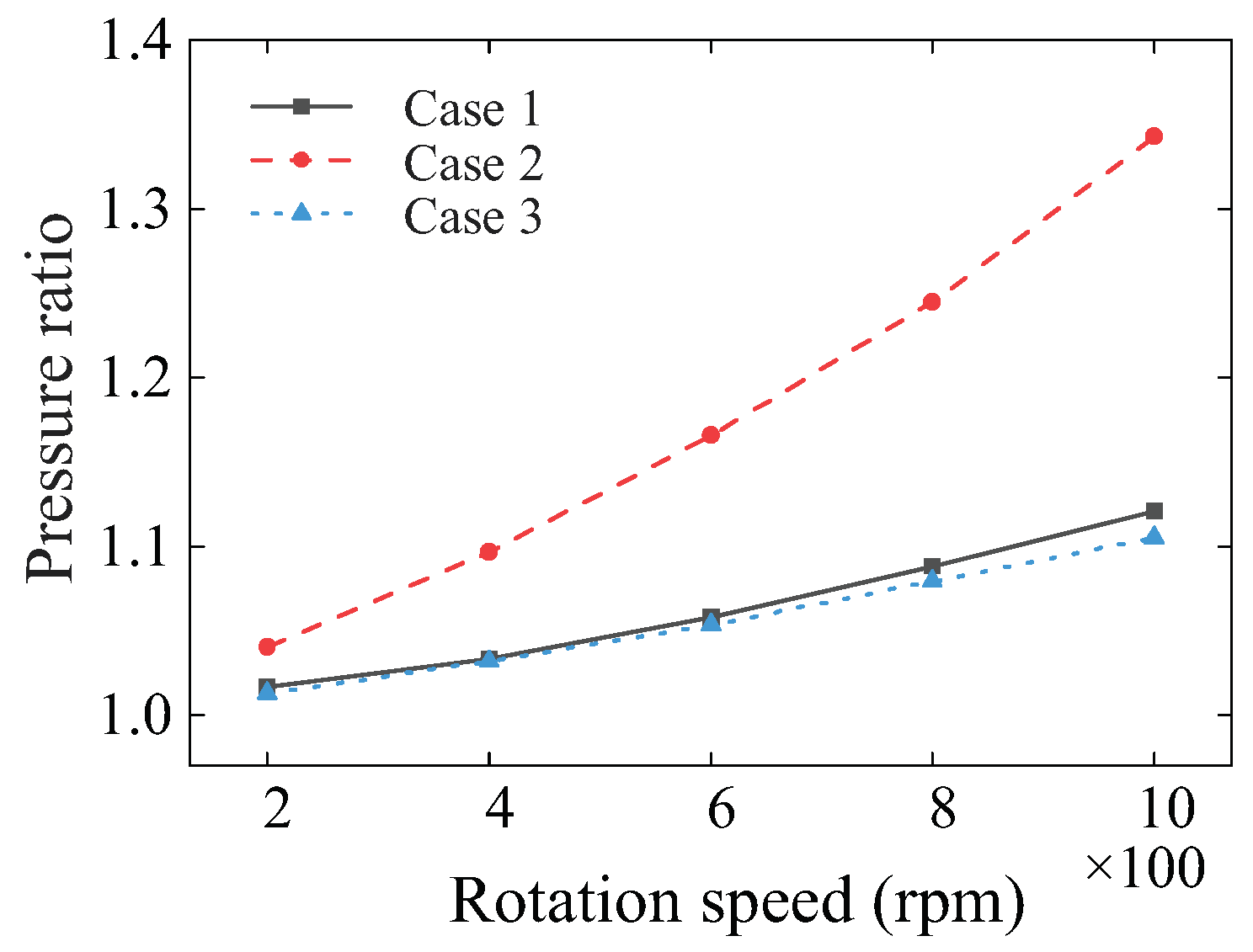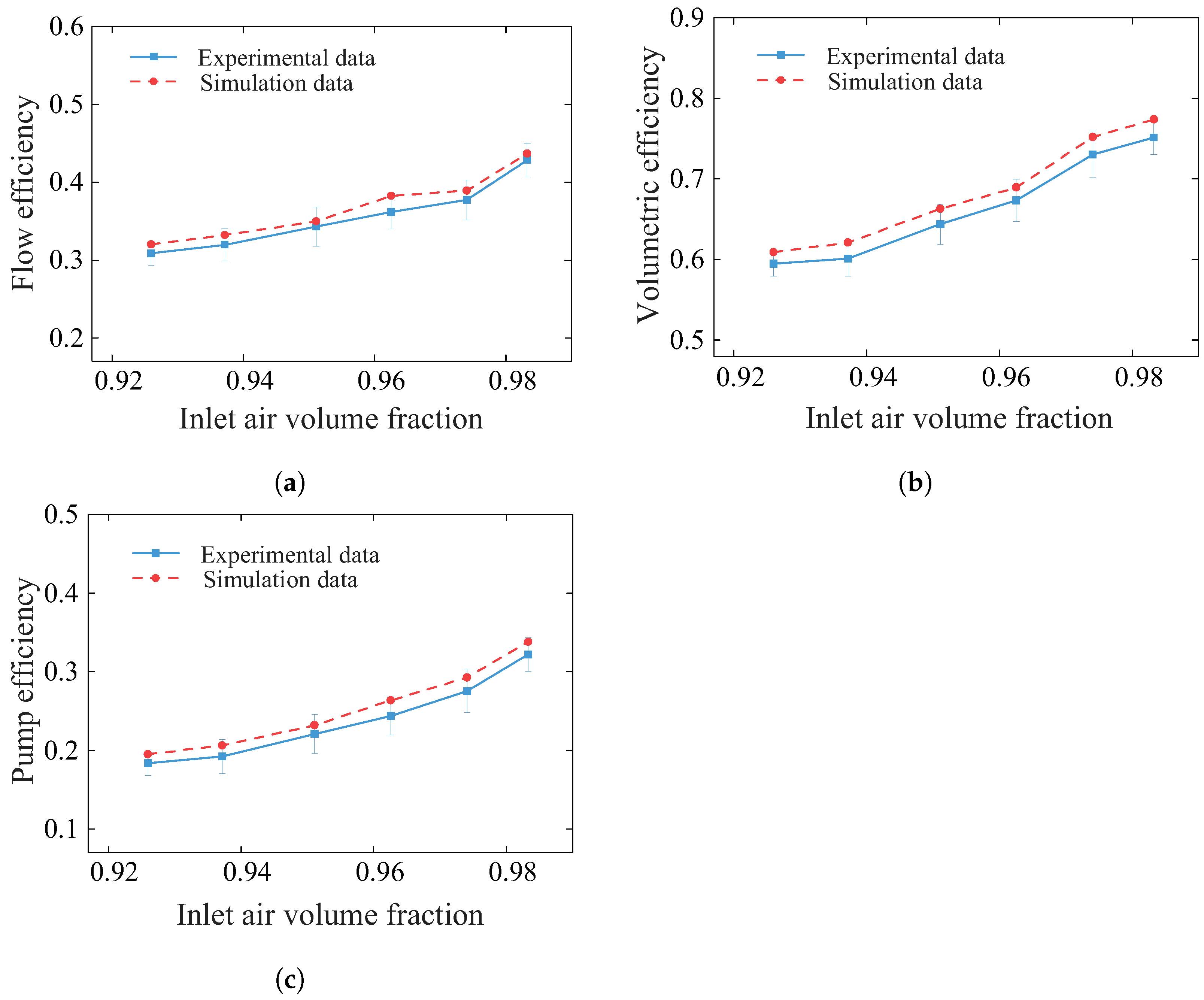Experimental Investigation and Numerical Validation of a Roots Pump’s Performance Operating with Gas-Liquid Mixtures
Abstract
:1. Introduction
2. Problem Formulation
3. Experimental Facility
4. Results and Discussion
4.1. Effect of Inlet Gas Volume Fractions
4.2. Effect of Rotational Speeds
4.3. Numerical Validation
5. Conclusions
- The Roots pump’s performance is significantly influenced by the inlet air volume fraction. In experimental conditions, the pump efficiency increased from 18.35% to 32.22% with the increasing air volume fraction in case 1. The leakage was affected by the inlet air volume fraction and the pressure difference. The water was able to reduce the rise in compression temperature. The high water volume fraction or low inlet air volume fraction leads to decreased pump efficiency.
- As the pressure ratio increases, the volumetric efficiency, flow efficiency, and pump efficiency of the Roots pump decrease. The pressure ratio has the potential to be further increased, but a progressively higher pressure ratio enhances the back-flow, leading to a decrease in the pump efficiency.
- The efficiency of the numerical and experimental methods was compared, and the maximum difference was 7.53%, indicating that the numerical model for the prediction of the performance of the gas-liquid two-phase Roots pump is acceptable. This can be used for following studies on the characteristics of the internal flow field of a gas-liquid two-phase Roots pump.
Author Contributions
Funding
Data Availability Statement
Conflicts of Interest
References
- Wang, X.; Shang, J.; Luo, Z.; Tang, L.; Zhang, X.; Li, J. Reviews of power systems and environmental energy conversion for unmanned underwater vehicles. Renew. Sustain. Energy Rev. 2012, 16, 1958–1970. [Google Scholar] [CrossRef]
- Kiely, D.H.; Moore, J.T. Hydrocarbon fueled UUV power systems. In Proceedings of the 2002 Workshop on Autonomous Underwater Vehicles, 2002, San Antonio, TX, USA, 21 June 2002. [Google Scholar]
- Qin, K.; Zhang, A.; Guo, Q.; Zhang, J.; Luo, K. Influence of operating conditions on in-tube vapour condensation heat transfer characteristics in the presence of noncondensable gases at high pressure. Appl. Therm. Eng. 2023, 226, 120243. [Google Scholar] [CrossRef]
- Yue, X.; Zhang, Y.; Su, Z.; Ba, D.; Wang, G.; Zhang, Z. CFD-based analysis of gas flow in dry scroll vacuum pump. Vacuum 2017, 139, 127–135. [Google Scholar] [CrossRef]
- Guo, G.; Zhang, R.; Jiang, L.; Yang, J. Study on mechanism of unsteady gas-liquid two-phase flow in liquid-ring vacuum pump. Vacuum 2024, 222, 113077. [Google Scholar] [CrossRef]
- Mansour, M.; Parikh, T.; Engel, S.; Thévenin, D. Numerical Investigations of Gas-Liquid Two-Phase Flow in a Pump Inducer. J. Fluids Eng. 2019, 142, 021302. [Google Scholar] [CrossRef]
- Guo, Q.; Qin, K.; Li, D.; Huang, C.; Luo, K. Numerical investigation and performance enhancement of roots pumps operating with gas-liquid mixtures. Vacuum 2020, 176, 109303. [Google Scholar] [CrossRef]
- Shao, C.; Li, C.; Zhou, J. Experimental investigation of flow patterns and external performance of a centrifugal pump that transports gas-liquid two-phase mixtures. Int. J. Heat Fluid Flow 2018, 71, 460–469. [Google Scholar] [CrossRef]
- Zhang, J.; Cai, S.; Li, Y.; Zhu, H.; Zhang, Y. Visualization study of gas-liquid two-phase flow patterns inside a three-stage rotodynamic multiphase pump. Exp. Therm. Fluid Sci. 2016, 70, 125–138. [Google Scholar] [CrossRef]
- Zhang, F.; Bohle, M.; Yuan, S. Experimental investigation on the performance of a side channel pump under gas-liquid two-phase flow operating condition. Proc. Inst. Mech. Eng. Part A J. Power Energy 2017, 231, 645–653. [Google Scholar] [CrossRef]
- Luo, X.; Yan, S.; Sun, S.; Feng, J.; Xie, H.; Zhang, L.; He, D. Experimental study of gas-liquid two-phase operating characteristics and bubble evolution law of a semi-open mixed-flow pump. Ocean. Eng. 2023, 272, 113733. [Google Scholar] [CrossRef]
- Yang, X.; Hu, C.; Hu, Y.; Qu, Z. Theoretical and Experimental Study of a Synchronal Rotary Multiphase Pump at Very High Inlet Gas Volume Fractions. Appl. Therm. Eng. 2017, 110, 710–719. [Google Scholar] [CrossRef]
- Ge, Z.G.; Feng, J.J.; Luo, X.Q.; Zhu, G.J.; He, D.H. Numerical investigation of gas-liquid two-phase performance in a mixed-flow pump by using a modified drag force model. Phys. Fluids 2023, 35, 053324. [Google Scholar]
- Wang, J.; Zha, H.; McDonough, J.; Zhang, D. Analysis and numerical simulation of a novel gas-liquid multiphase scroll pump. Int. J. Heat Mass Transf. 2015, 91, 27–36. [Google Scholar] [CrossRef]
- Luo, X.; Xie, H.; Feng, J.; Ge, Z.; Zhu, G. Influence of the balance hole on the performance of a gas-liquid two–phase centrifugal pump. Ocean. Eng. 2022, 244, 110316. [Google Scholar] [CrossRef]
- Hong, S.; Son, G. Numerical study of a vane vacuum pump with two-phase flows. J. Mech. Sci. Technol. 2017, 31, 3329–3335. [Google Scholar] [CrossRef]
- Lobsinger, T.; Hieronymus, T.; Brenner, G. A CFD Investigation of a 2D Balanced Vane Pump Focusing on Leakage Flows and Multiphase Flow Characteristics. Energies 2020, 13, 3314. [Google Scholar] [CrossRef]
- Zhang, W.; Yu, Z.; Zahid, M.N.; Li, Y. Study of the Gas Distribution in a Multiphase Rotodynamic Pump Based on Interphase Force Analysis. Energies 2018, 11, 1069. [Google Scholar] [CrossRef]
- Feng, J.; Xing, L.; Wang, B.; Wei, H.; Xing, Z. Effects of Working Fluids on the Performance of a Roots Pump for Hydrogen Recirculation in a PEM Fuel Cell System. Appl. Sci. 2020, 10, 8069. [Google Scholar] [CrossRef]
- Zhang, R.; Guo, G. Experimental study on gas-liquid transient flow in liquid-ring vacuum pump and its hydraulic excitation. Vacuum 2020, 171, 109025. [Google Scholar] [CrossRef]
- Li, G.; Ding, X.; Wu, Y.; Wang, S.; Li, D.; Yu, W.; Wang, X.; Zhu, Y.; Guo, Y. Liquid-vapor two-phase flow in centrifugal pump: Cavitation, mass transfer, and impeller structure optimization. Vacuum 2022, 201, 111102. [Google Scholar] [CrossRef]
- Hsieh, C.F.; Zhou, Q.J. Fluid analysis of cylindrical and screw type Roots vacuum pumps. Vacuum 2015, 121, 274–282. [Google Scholar] [CrossRef]
- Sun, S.K.; Zhao, B.; Jia, X.H.; Peng, X.Y. Three-dimensional numerical simulation and experimental validation of flows in working chambers and inlet/outlet pockets of Roots pump. Vacuum 2017, 137, 195–204. [Google Scholar] [CrossRef]
- Kong, X.; Han, J.; Guo, Y.; Feng, J.; Peng, X. Investigation on the pressure fluctuation of hydrogen Roots pump with a novel reflow structure for fuel cell vehicles. Int. J. Hydrogen Energy 2024, 50, 66–78. [Google Scholar] [CrossRef]
- Guo, Q.; Luo, K.; Li, D.; Huang, C.; Qin, K. Effect of Operating Conditions on the Performance of gas-liquid Mixture Roots Pumps. Energies 2021, 14, 5361. [Google Scholar] [CrossRef]
- Menter, F.R. Two-equation eddy-viscosity turbulence models for engineering applications. AIAA J. 1994, 32, 1598–1605. [Google Scholar] [CrossRef]








| Parameters | Values |
|---|---|
| Blade outer radius, | 37.5 mm |
| Blade valley radius, b | 25 mm |
| Width of blade protrusion, d | 37.36 mm |
| Blade center distance, a | 50 mm |
| Blade thickness, L | 87.3 mm |
| Casing diameter, | 75 mm |
| Casing center distance, | 64.8 mm |
| Casing thickness, | 87.4 mm |
| Blade number, z | 2 |
| Case 1 | ||||
| Inlet Gas | Liquid Volumetric | Air Volumetric | Inlet Pressure | Outlet Pressure |
| Volume Fraction | Flow Rate, L/h | Flow Rate, g/s | Pa | Pa |
| 0.9260 | 350 | 2.386 | 99,197 | 147,823 |
| 0.9372 | 300 | 2.414 | 99,202 | 141,213 |
| 0.9511 | 250 | 2.450 | 99,081 | 133,589 |
| 0.9626 | 200 | 2.480 | 99,006 | 129,916 |
| 0.9741 | 150 | 2.510 | 98,973 | 121,451 |
| 0.9833 | 100 | 2.582 | 98,833 | 115,291 |
| Case 2 | ||||
| 0.9182 | 350 | 2.329 | 99,423 | 215,638 |
| 0.9232 | 300 | 2.378 | 99,350 | 200,235 |
| 0.9332 | 250 | 2.404 | 99,289 | 176,632 |
| 0.9503 | 200 | 2.447 | 99,169 | 162,426 |
| 0.9682 | 150 | 2.494 | 99,151 | 147,884 |
| 0.9807 | 100 | 2.525 | 99,117 | 135,120 |
| Case 3 | ||||
| 0.9271 | 350 | 2.397 | 99,163 | 147,541 |
| 0.9384 | 300 | 2.418 | 99,135 | 141,121 |
| 0.9526 | 250 | 2.454 | 99,034 | 133,526 |
| 0.9621 | 200 | 2.479 | 99,012 | 129,938 |
| 0.9737 | 150 | 2.508 | 98,992 | 121,501 |
| 0.9847 | 100 | 2.593 | 98,786 | 115,247 |
| Case 1 | |||
| Rotational Speed | Air Volumetric Flow Rate, m3/h | Inlet Pressure Pa | Outlet Pressure Pa |
| 200 | 2.4 | 99,304 | 100,990 |
| 400 | 4.8 | 99,094 | 102,400 |
| 600 | 6.8 | 98,692 | 104,429 |
| 800 | 8.8 | 98,255 | 106,922 |
| 1000 | 10.7 | 97,774 | 109,594 |
| Case 2 | |||
| 200 | 2.3 | 99,241 | 103,249 |
| 400 | 3.8 | 99,016 | 108,595 |
| 600 | 6.2 | 98,813 | 114,955 |
| 800 | 7.0 | 98,573 | 122,617 |
| 1000 | 8.5 | 98,409 | 131,868 |
| Case 3 | |||
| 200 | 2.5 | 99,002 | 100,840 |
| 400 | 4.9 | 98,961 | 102,024 |
| 600 | 6.9 | 98,570 | 103,820 |
| 800 | 8.8 | 98,107 | 105,816 |
| 1000 | 10.9 | 97,956 | 108,640 |
| Inlet Air Volume Fraction | Numerical Volume Flow Rate, m3/h | Experimental Volume Flow Rate, m3/h | Deviation |
|---|---|---|---|
| 0.9260 | 4.88 | 4.72 | 3.28% |
| 0.9372 | 4.95 | 4.77 | 3.64% |
| 0.9511 | 5.26 | 5.11 | 2.85% |
| 0.9626 | 5.54 | 5.35 | 3.43% |
| 0.9741 | 6.01 | 5.80 | 3.49% |
| 0.9833 | 6.18 | 5.97 | 3.40% |
Disclaimer/Publisher’s Note: The statements, opinions and data contained in all publications are solely those of the individual author(s) and contributor(s) and not of MDPI and/or the editor(s). MDPI and/or the editor(s) disclaim responsibility for any injury to people or property resulting from any ideas, methods, instructions or products referred to in the content. |
© 2024 by the authors. Licensee MDPI, Basel, Switzerland. This article is an open access article distributed under the terms and conditions of the Creative Commons Attribution (CC BY) license (https://creativecommons.org/licenses/by/4.0/).
Share and Cite
Qin, K.; Zhang, Y.; Yan, T.; Guo, Q.; Luo, K. Experimental Investigation and Numerical Validation of a Roots Pump’s Performance Operating with Gas-Liquid Mixtures. Processes 2024, 12, 1918. https://doi.org/10.3390/pr12091918
Qin K, Zhang Y, Yan T, Guo Q, Luo K. Experimental Investigation and Numerical Validation of a Roots Pump’s Performance Operating with Gas-Liquid Mixtures. Processes. 2024; 12(9):1918. https://doi.org/10.3390/pr12091918
Chicago/Turabian StyleQin, Kan, Yuhang Zhang, Tianshuo Yan, Qing Guo, and Kai Luo. 2024. "Experimental Investigation and Numerical Validation of a Roots Pump’s Performance Operating with Gas-Liquid Mixtures" Processes 12, no. 9: 1918. https://doi.org/10.3390/pr12091918







